
|  |

|  |
 e-mail: khokar1960@gmail.com Old n new winds! November 15, 2024 In dance, like in wine, old is gold. Guru Anuradha Shridhar is one such gold in the field of Indian dance, who has kept the tradition intact, trained new generation well and maintained dignity and standards in the form. She's a chip off the old block, so to say. Anuradha's early life and dedication to Bharatanatyam are deeply rooted in her cultural heritage and familial background. Born into a family of musicians and Vedic scholars, with her father, the late H.S. Chandrashekhar Shastri being a revered mridangam vidwan and Vedic scholar, and her mother, Leela Shekhar, also a musician and homemaker, she was naturally immersed in the world of music and dance from a young age. Guru Anuradha began her Bharatanatyam training at the age of six under the guidance of the late teacher Sundar Kumar and continued her studies under Guru Radha Shridhar throughout her school years, taking part in numerous productions and performing major roles. Her exposure to the Kalakshetra style of Bharatanatyam at the age of 15 was a turning point in her journey, and she developed a deep admiration for its disciplined, graceful technique and expressive storytelling. Fuelled by a desire to refine her skills and immerse herself in the rich tradition of Kalakshetra, Anuradha pursued her formal training at the prestigious Kalakshetra College of Fine Arts in Chennai after completing her B.Com at BMS College in Bengaluru. Her dedication and talent were evident when she graduated in 1993 with first rank honors, cementing her reputation as a skilled Bharatanatyam dancer. 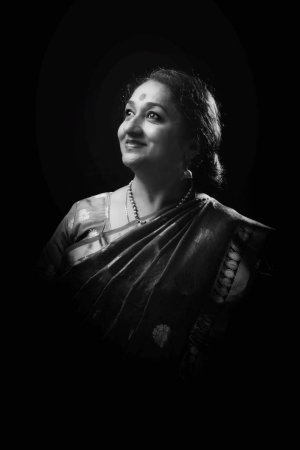 Anuradha Shridhar After her marriage in the year 1991, Shridhar and Anuradha started performing together as a duo. Their stunning coordination, impeccable nritta, and deeply moving abhinayam are a feast to the connoisseurs. They received tremendous appreciation for their choreography, which is remarkably creative, imbued with deep spiritual overtones and reflects extensive research. Insatiable passion towards the art and fierce dedication has placed them among the foremost dancing couple in the country today. Without compromising the essential aesthetics of Bharatanatyam, the couple with great dexterity, depth of understanding, have woven into the fabric of their dance, episodes from epics and great literary works that highlight human emotional conflicts, and spiritual values of life. Their dance features have received international acclaim. Their choreographic feature, The Upanishad which explains the concepts and message of the Upanishads, received high appreciation. To pass on the rich legacy they have received from great gurus, Dr.Shridhar and Anuradha have established Khechara Academy of Bharatanatyam in 1994. Here they train disciples in the achievement of true classical excellence. The couple have dedicated their lives for the preservation and propagation of Bharatanatyam as well as the rich cultural heritage of India. Apart from many awards and distinctions, Anuradha has also acted in a few Kannada films, including Mahasadvi Mallamma and Balashiva, among others, playing the role of Goddess Parvati. 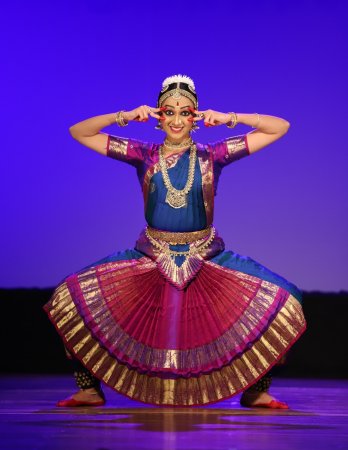 Snigdha Krishna Why this long preamble was needed was to share with younger teachers today that only such an accomplished dancer-teacher can cut a first rate diamond like Snigdha Krishna we saw in a debut show. Problem with such shows is, these are platformed as arangetrams or debut but there's NOTHING amateurish about the levels of presentation. Snigdha is just 20 or so but stands tall as a professional, which even some established names fail to impress. In all items of the margam she undertook, not one was out of form or pace. Even the varnam was a full 40 minutes, a real test. No point going into item-wise description much after the show (that can be seen on YouTube). What's more important is to tell young ones: First learn to walk, then try to run. Dance is a skill when one starts learning. After years of learning, it becomes a craft. Then with hard work, Art. If maha gifted and lucky, then a star. Snigdha Krishna has all the above qualities to become one. What's star quality? Not fame, that's a byproduct. It means in dance field - perfection, staying power and depth. Hard work and blessings of gurus and support of parents. The live music was first rate, except the rhythm pad destroyed the beauty of natural sounds of mridangam and dominated the whole orchestra. This is not a ballet or dance-drama production where sound effects are needed. Speeches were mercifully short and sweet! And Snigdha did not smile endlessly as some dancers think it ought to be done. In fact, in the first half she didn't at all. She danced with her mouth closed. Which means no huffing and puffing. She has stamina. Then, in the second half, either she was relaxed or someone must have told her at change of costume in green room," smile, kanne, smile". And she did. Other things being equal, she will go far, with guru's grace and fair winds blowing her way. S for Sampada and sharp, sweet baby tai steps, well-turned out group and solo works and a good evening of Kathak was seen at the drab Seva Sadan hall. The whole place looks like a shed. No artistic feel. Patron Vimala Rangachar is too old to look into the affairs of two main dance shows halls - the ADA Rangamandira and the Seva Sadan - and the staff doesn't care one bit, even after charging good rentals. Trustees, please wake up and look into the running of the two halls, built on prime public land. Even if not, they charge good rentals, so should deliver minimally. 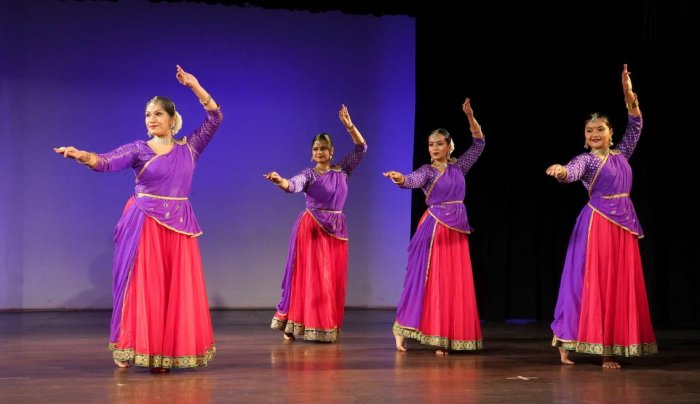 Sampada Pillai group Sampada Pillai settled in the city over a decade ago from Goa. Trained in Rohini Bhate (fondly called Baby Tai) type of Pune Kathak (where footwork is strong, music superb but facial expressions less), she with 3 students acquitted well. First the positives (for me the glass is always half full): sharp footwork / layakari (even if sound track was muffled); good film vignettes of the great guru whose centenary too is in 2024 and variety of talents like Sunil Sunkara, the happening boy wonder of that belt of Maharashtra (Bombay- Pune - add Indore -Bangalore); a Mangalorean gem Akshatha Ameena (with first rate foundation and stage presence) and a senior Bangalorean Nandini Mehta. Sampada Pillai runs the Ridham school of Kathak in Yelahanka area of outer Bangalore, where lots of new residents have made home, so she is an asset in that area to learn Kathak from. She is sincere and serious. She also is academic and not just an item girl. Item girls or boys are those today who know only seven to ten items and NOTHING more: no history, no background, no real mythology, no GSP (that's Guru Shishya Parampara) or more. They don't care also because dance is a hobby for them. Today this, tomorrow para gliding. While India is a free country and everyone has rights - more than many other countries - the professional dance field is not casual. Or music field, classical. Casio learning all are welcome to but serious art, no. No frills, no fancy, just direct dance is what Sampada Pillai shared. The costumes were bright enough that even alta was not needed on feet! Dancers don't realise it is not merely a decoration: It is energizing and highlighting the chakras. Sri Chakra in palm and delineation of earth from sky, on feet. Since feet touch the stage first, the alta demarcates that space. Alta is red and not green for a reason: red represents shakti. Also, feet are seen first by professionals, not the face. That's last of all. Feet, body movements, arms for correct positions then hasta (not mudras, as many say wrongly. Hastas is in dance; mudras is in iconography) then lastly, the face. Either it registers or it doesn't. Face is not the only fortune in dance; feet too are. In Sampada Pillai group, Seema Krishnan had the most shapely and light feet in the group of four and also undertook chakras on toes, not heels. Sampada Pillai's feet were firm and sharp. What a happy sound to hear clear thapp and see a good thhaat. Sampada's students Sakshi Taula, Mimansa Verma and Seema Krishnan did their guru proud. There was harmony in what they did. As hosts and the only group of the evening, they should've gone last and let a senior soloist Nandini Mehta perform first. But by going first they also got free to help others backstage, as one could see. South Indian comperes need to check north Indian words with artistes backstage - Urdu or Hindi words like aamad was pronounced 'a-mud' and the compere also was democratic enough to give instant reviews! While humour works, opinions don't. She did manage well - since backstage and in the wings, one could see much confusion prevail because the hall is so bad. Everything can be seen from the audience and believe me it ain't such a pretty sight. Akshatha Ameena from Mangalore showed first rate tayari. What does that mean? Entries, exit, stage sense and foundation. It also means a professional outlook, with alta and all. Dancers like her bring true joy to rasikas and enthuse others to learn too. In all that she undertook, there was finish. Her art has balance and beauty. Need more be said? 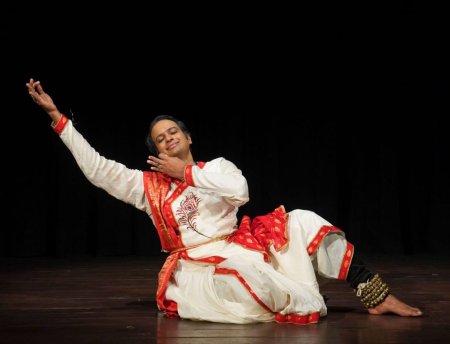 Sunil Sunkara Sunil Sunkara is unusually tall and hefty (especially for small stage) but nimble and agile in rendition. His white dhoti costume with black leotards showing under it, looked clumsy but he danced with full flair. With his weight, if he can fly then it shows dexterity! Taking up themes that are done to death in Kathak - like Meera - he being an upcoming academic in the field too, tried to invest a patina of history merged with mythology. Chittor king Bhojraj Singh Sisodia was the focus, more as an understanding husband to Meera then as a fighting Rajput. Sunil has three things going for him: grace, face and race. Grace first. He has inborn lasya, looks tandava and acts auchitya. Let me explain all these Sanskrit and very technical dance words: Lasya means a certain softness and delicateness in delivery where lines are not angular but flow. A flowery quality. The feminine aspect. Tandava doesn't mean just destruction! The are seven types. It represents male energy, a certain firmness and strength in execution. Masculine. And auchitya means appropriate, not overdoing abhinaya. Some get carried away while emoting. He tries to maintain a balance between all 4 aspects of dance - Aangika, Aaharya, Vaachika, Saatvika. Face means in today's scheme of things not facebook! but that he has a face that lends to various characters. He can be child Krishna or a grown-up Maharaja, Meera or Krishna. Race means he is getting patronage from all and thus he is ahead suddenly of his contemporaries. It happens sometimes to some: suddenly the universe conspires and acche din comes. Awards, scholarships, shows, travel, committees and more. Kismet and karma. One thing about him is saatvika. He looks peaceful, happy and spiritual. Maybe the alliance with Sri Sri Ravi Shankar foundation (compere added pandit, making a few smirk in the audience for the locals knew it was their resident oxygen giving guru - sudarshan kriya - and not the sitar maestro she was referring to). 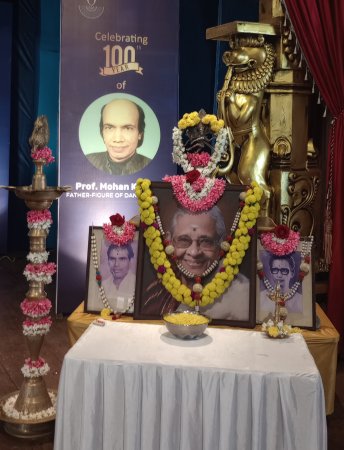 Guru Jayalakshmi Alva with guru Dandayudhapani Pillai Speaking of Sathvika, what a natural talent this Mangalore based shy dancer is but then she is genetically coded: mother is Araty Shetty, a benign, do-gooder Mangalore University dance talent and grandmother is Jayalakshmi Alva, an ace disciple of the great vadiyar Dandayudhapani Pillai. She taught Waheeda Rahman and Sonal Mansingh too. A local legend. In a finely mounted competition of local talents, 15 were shortlisted, of which 3 were selected as finalists. Yuva Kala award winners were: a complete dancer called Mythreya Navada; a boy from Mysore maintaining excellent positions called Sudhanava and an able local lass from nearby Udupi, Sathyashree. Fellow judge Naina Shenoy, a true Mangalore beauty of BN, helped select. 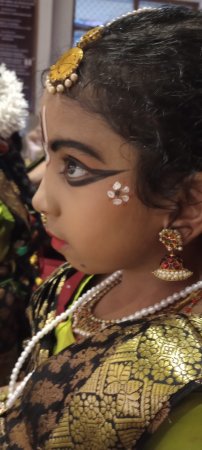 Sadhya Rai Then Dr. Vidhi Nagar of BHU was honoured with the Alva award titled 'Jayakala Prashasthi'. She is a chulbul pande type from Hindi heartland, full of spunk and substance. Then a fine dance-drama production Krishna Prana where everyone was given an apt role, was showcased. So an over-democratic body was Gajendra who got Moksha (his happy face showed he loved dancing); Sathvika as mother Yashodha was in element and small kids were part of Krishna gang stealing butter. Sathvika's daughter Sadhya Rai is a natural. Prof. Radhakrishnan spoke well and so did Shalini Ayyappan. It was an enjoyable function, full of goodness of heart in art. 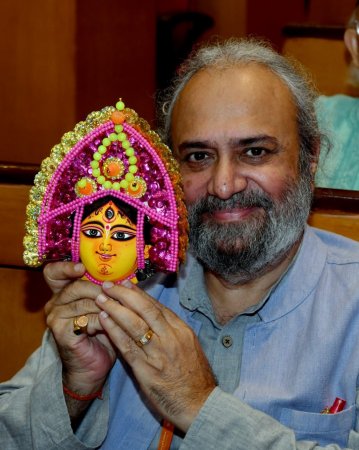 Critic, connoisseur, historian, author, artivist, archivist, administrator and more - editor, columnist and mentor Ashish Khokar remains true to his muse. More on attendance-india.com Responses * We as parents of Snigdha would like to thank you, Khokarji, for your wonderful words and blessings on our daughter. And I would like to thank gurus Dr Shridhar and Anuradha Shridhar for shaping our daughter and showing the path of divine art form of Bharatanatyam. I take this opportunity to mention here that Snigdha learnt the art form for 10 years under Dr.Shridhar and last 2.5 years under Guru Anuradha Shridhar leading up to the successful conclusion of Rangapravesha. Thank you so much, Sir and Ma’am. - Divya Krishna (Nov 16, 2024) * Such a beautifully written article capturing the remarkable journey of our Guru Anuradha Shridhar in the world of Bharatanatyam. Her passion for the art form, meticulous attention to detail, and unwavering commitment to preserving its authenticity have been truly inspiring to all her students. I feel immense pride and gratitude to have learned under her guidance, as she not only imparts technical excellence but also nurtures a deep understanding of the emotion and spirituality that Bharatanatyam embodies. Congratulations to Snigdha on her arangetram, and heartfelt thanks to Narthaki for beautifully showcasing our guru’s unparalleled dedication, artistry, and enduring legacy in this timeless art form. - Aditi Shesh (Nov 16, 2024) * Thank you so much for writing this article on our beloved Anuradha mam. We are always grateful to our teachers for supporting and enlightening us all the way to be better human beings. Learning the art form from them has been a great experience, as they teach not only dance but discipline, dedication, and devotion to art. Being a student of Khechara Academy, am eternally grateful to have great Gurus like Shridhar sir, Anuradha mam and Anagha Akka. Thank you for all the goodness and advice you have showered us with and being the source of inspiration and guidance to many of us. - Chathurya (Nov 16, 2024) * Thank you, Ashish sir, for the beautiful presentation of different performances and the performers. Such a swell description of Anuradha mam. As a mother of a student at Khechara Academy, I am filled with gratitude for Shridhar sir and Anuradha mam. The students at the Academy are not only trained in the art of dance but also guided with human values. True picture of Guru-Shishya parampara. The effort and dedication shown by Ma’am and Sir for the performances at the academy are commendable. I always feel the presence of divinity in the performances of students. We are blessed to witness such performances. - Lakshmi Sudha Dubey (Nov 16, 2024) * My daughter Bandhavi is blessed to have you both as Gurus - Anuradha Ma’am and Shridhar Sir. Your dedication and passion towards dance is endless. It carries both discipline and culture towards our future generations. Thank you so much, Ashish Sir, for your wonderful article. - M Shilpa (Nov 16, 2024) * This article is beautifully written. Anuradha ma’am is indeed the best dancer and guru out there. My daughter Lakshmi Nandhana is lucky to be learning this amazing art under her guidance. She has truly brought out the best in her mentally, physically and spiritually. Thank you so much for carrying the amazing culture of our country and glorifying it with such grace, commitment and devotion. Extremely blessed. - P Bhavitha (Nov 16, 2024) * A fine diamond needs to go through a lot of pain as a stone to be called as diamond. There are many such diamonds that are crafted carefully to perfection. Why am I talking about diamonds on this platform… well it's because that's what Anuradha ma’am does to each and every child she teaches. I have been a student of sir and ma’am myself, but due to my education, I had to discontinue. My dreams of being a dancer is being fulfilled by my daughter Kashvi who is being beautifully crafted under the love of Ma’am. Yes, the pure and unconditional love maam showers on each child is just like she does on Anagha, her daughter. As sir has rightly said in the article, the arangetram is just a name, they are so well prepared for their exams that they have the confidence to face the audience then itself. We are blessed to be under her guidance as parents. Thank you, ma'am, for taking our children as your shishyas. No words to express my gratitude for the dedication you show towards making each one of them perfect. - Shriti (Nov 15, 2024) * It's the most gratifying and fulfilling feeling to read your article on Guru Anuradha and of course, Snigdha as well. We, as parents and Snigdha, feel indebted for those kind but apt paragraphs. Yes, coming from a true connoisseur of the Indian art form with decades of experience in the field having watched innumerable talents perform on various stages means Snigdha is on the right track. Indeed, Guru Anuradha Shridhar has been a remarkable teacher upholding the true virtues of the classical art form with absolute devotion and diligence. A stickler to the norms and a tough task master to the core, but with a heart of gold. Pray to the Almighty to bless her with an abundance of energy and zeal to go about shaping innumerable wannabe dancers. Snigdha is indeed blessed to be firmly ensconced under her wings. Apt to also remember and mention Guru Shridhar whose contributions are immense to the field of Bharatanatyam per se. Of course, in giving a definite shape to Snigdha's fledgling ambitions a decade back, it's truly been one fascinating but eventful journey under his expert guidance for Snigdha. It’s very rare to find such a supremely dedicated Guru. May his tribe keep growing perpetually. With Guru’s guidance and the foremost art historian’s kind blessings, Snigdha will be well prepared to traverse the challenging road ahead in her pursuit of the divine art form. As parents, we earnestly hope and pray Snigdha's future endeavours would be noticed and blessed. - MV Krishna (Nov 15, 2024) * The great inspiring journey full of artistic creations and contributions of the accomplished artiste couple Anuradha Shridhar and Dr Shridhar, has been well covered by such a renowned historian. This indeed goes into history as deserved. Snigdha, a natural talent well-groomed by gurus, deserved every appreciation the author has showered here… having seen her very awesome performance. My hearty congratulations to the Gurus and the star disciple! - Ashok (Nov 15, 2024) * First of all, thank you, Sir, for this wonderful article on our beloved Guru, Anuradha ma’am. She is the epitome of Kalakshetra Bharatanatyam. Not only that, she is also an inspiration to many people. She easily understands her students' minds and helps them cultivate their overall personality. We are very blessed to have Shridhar Sir and Anuradha ma’am as our Gurus. Thank you very much. - Yashaswini (mother of Adithi Vikram) (Nov 15, 2024) Post your comments Please provide your name and email id when you use the Anonymous/blog profile to post a comment. All appropriate comments posted with name and email id in the blog will also be featured in the site. |